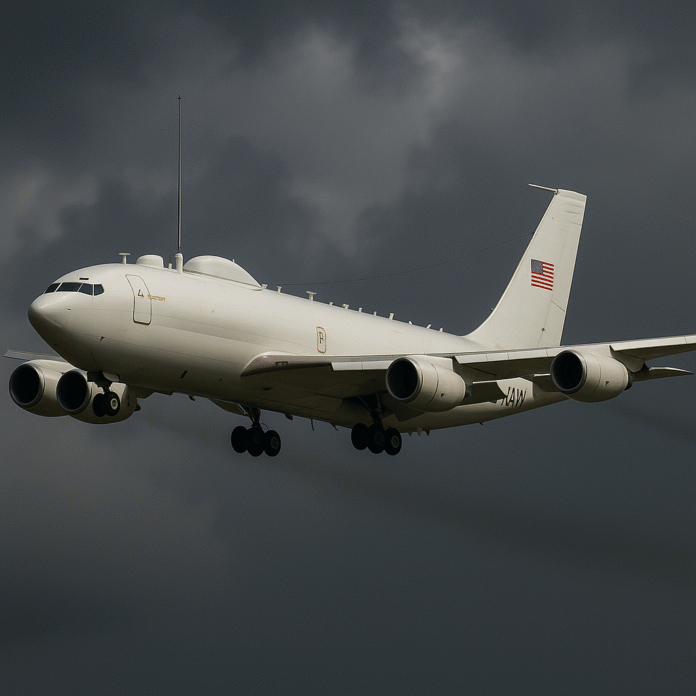Introduction :
As tensions escalate between Israel and Iran, global attention has sharply turned to the United States’ strategic military movements—especially the sighting of its so-called ‘Doomsday Plane’ officially known as the E-6B Mercury. This aircraft, engineered to withstand a nuclear blast and maintain national command and control functions, has become a symbol of readiness and deterrence during times of high geopolitical uncertainty.
But what exactly is the Doomsday Plane, why is it being deployed now, and what does its presence signal in the context of the growing Israel-Iran conflict?
What Is the US ‘Doomsday Plane’?
The E-6B Mercury, dubbed the “Doomsday Plane”, is a modified Boeing 707 operated by the US Navy’s Strategic Communications Wing 1. Designed during the Cold War, it serves a critical role in the nuclear command, control, and communications (NC3) system.
Key functions include:
- Relaying orders from the President to US nuclear submarines, bombers, and missile silos.
- Withstanding electromagnetic pulses (EMPs) caused by nuclear explosions.
- Staying airborne for extended periods with aerial refueling.
Its primary mission: Ensure continuity of nuclear command in a crisis.
Why Is It in the News Now?
Recent sightings of the Doomsday Plane flying over or near Europe and the Middle East have raised eyebrows. This comes amid escalating military exchanges between Iran and Israel, including:
- Israel’s alleged covert operations inside Iran.
- Iran-backed proxies attacking Israeli or US interests in the region.
- Unconfirmed reports of possible nuclear facility threats.
The US has not officially confirmed the purpose of the flight. However, its visibility is not accidental—these missions are often meant to send strategic signals.
What It Signifies in the Israel-Iran Conflict
- Signal of Readiness and Deterrence
- The US is sending a clear message to adversaries: its nuclear command infrastructure is on alert and fully functional.
- It’s a form of psychological warfare, reminding both Iran and its proxies of the potential consequences of escalation.
- Support for Israel Without Direct Engagement
- While President Biden has urged restraint and de-escalation, flying the E-6B Mercury demonstrates implicit support for Israel’s national security.
- Reassurance to Allies
- Countries in the region, especially NATO allies and Gulf States, are reassured of the US commitment to maintaining regional stability and deterrence posture.
- Preparing for Contingencies
- The deployment may be part of contingency planning, in case the conflict crosses red lines—such as direct attacks on US personnel or facilities, or the use of weapons of mass destruction.
Is War Imminent?
Not necessarily. Military posturing doesn’t always mean an attack is imminent. Instead, it’s a strategic move in international diplomacy, often intended to:
- Prevent further escalation,
- Establish military superiority,
- And leave open diplomatic solutions under the shadow of overwhelming force.
The Doomsday Plane, therefore, acts as a floating command center and a deterrent tool, not just a wartime instrument.
The Bigger Picture: Nuclear Stability in a Volatile Region
The Israel-Iran rivalry has always carried nuclear undertones. Israel is widely believed to possess nuclear weapons (though it has never officially confirmed), while Iran’s nuclear ambitions have been a global concern for decades.
The US deploying its nuclear-ready assets—like the Doomsday Plane—amid such tensions highlights:
- The fragile balance in the Middle East.
- The role of advanced deterrent systems in maintaining that balance.
- The potential global impact if regional players were to miscalculate or misinterpret such deployments.
Conclusion:
The appearance of the US Doomsday Plane amid the Israel-Iran war tensions is not merely a show of strength—it’s a strategic message. It represents preparedness, deterrence, and continuity of command in extreme scenarios. While it doesn’t necessarily signal that conflict is about to escalate into nuclear war, it underscores the high stakes and the serious caution with which global powers are monitoring this volatile situation.
As the world watches, this high-flying symbol of military resilience reminds everyone of the thin line that separates deterrence from destruction—and the critical role diplomacy must play in walking that line.



